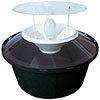Buying a Moth Trap
I can’t claim to be an expert in the world of Moth trapping and moth traps, but I’m keen to get started and have been doing some research into the best traps to get so thought I’d share my findings here. Hopefully it will be of use to people in the same position as me who would like to start moth trapping but don’t know which moth trap would be the best to get.
The Basics.
As a beginner I’m guessing that like me you don’t want to spend too much money on a moth trap. Afterall you don’t know if you’ll get into it properly so minimal outlay would be ideal. In basic terms a moth trap is simply a bright light that attracts the moths, attached to a box that the moths enter but have difficulty in getting out of. It isn’t anything more sophisticated than that but there are various designs.
The main designs are the Robinson, the Skinner and the Heath traps.
Probably the cheapest solution is to make your own, but there are some ready-made versions available that are pretty competitive too.
The Light
The light is used to attract moths. To a certain extent, bigger and brighter is better as a brighter light will be seen from further away and will therefore attract more moths. In theory this should give you a better catch rate and therefore increase the number of species too.
It isn’t true that different types of light attract different species. Each light should attract the same range of species, but if your light can be seen from further afield you may be attracting moths from slightly different habitats with a brighter light and therefore attracting a wider range of species.
However, there are certain downsides to the bigger, brighter lights. They are more expensive to buy and just as importantly more expensive to run. They may not use lots of electricity but if you are running a moth trap all night every night then it all adds up. Also, as potential moth trappers I’m sure you are trying to be as environmentally friendly as possible, so using a moth trap that uses less energy has to be a good thing.
Secondly, the brighter lights may annoy neighbours, especially in built up areas whereas a less bright light will be less intrusive.
The two main types of bulbs used are Mercury Vapour (MV) bulbs and Actinic bulbs.
The MV bulbs (usually 125W) have a good catch rate but are extremely bright, making them less suitable for built-up areas or situations where there will be people around. It is also a hot bulb which needs protection from rain and requires a 240V, mains or generator power source.
Actinic Tubes come in a variety of powers (e.g. 6, 8, 15, 22 and 40w). They have a lower catch rate due to the lower wattage, but the relatively low visible light emission makes it good for garden or educational use. It is a cold bulb that doesn’t require protection from light rain. It can be run from the mains, a generator, or 12V battery.
The Box
The catch box sits under the light and should allow moths to enter easily but not escape. The expensive ‘Robinson’ traps retain moths better than the Skinner or Heath traps which may allow some moths to escape.
Again, in an ideal world it is a case of the bigger the better. A bigger trap will allow more moths to be safely and comfortably trapped. However there are certain restrictions. Larger traps are more expensive to buy or build and less portable.
Other things to bear in mind when choosing the best combination of light and box are that certain traps are designed to be used with certain lights so you should make sure the combination you choose will work in conjunction with each other.
Biggest and brightest isn’t always the best. A large trap with a powerful lamp will attract and catch more moths, but all of the moth traps attract the same range of species. It will take time to go through and identify the moths you catch, especially when starting out, so having fewer moths to identify each morning may not be a bad thing. A smaller trap with a less bright light will be less expensive to buy, less expensive to run, less intrusive and more manageable.
Buying a ready made moth trap
Considering that all moth traps really are is a box and a light, then most of the the ready made ones are pretty expensive. At the time of writing, a Robinson Trap complete with 125W MV lamp and electrics will set you back close to £300. A Skinner Trap is much cheaper at around £150 with a 15W Actinic lamp. A small Heath Trap with a 6W Actinic bulb is a little less expensive at around £115. There are some slightly cheaper alternatives that I’ll mention in a bit.
Building your own moth trap
The Skinner traps are the best types to make as DIY projects and a plan can be found here:
http://www.atropos.info/gardenmoths.html
You will still need to buy the electrics and make sure that they are properly wired and set up for use outdoors. Building your own could be the cheapest option, but only just.
My Ideal Moth Trap
I’ve decided against the DIY solution though for a couple of reasons. First I’ll probably never get around to it, and secondly by the time I’d bought the materials and the electrical components I’d probably be looking at around £60. Much cheaper than the ‘proper’ manufactured traps, but I have found a very competitive alternative. The ‘Gladiator’ moth trap. (http://www.pwbelg.clara.net/mercury/gladiator/index.html).
These seem to be made by an enthusiast (Paul Batty) so have a home-made look to them but are supplied ready made and ready to go. The Gladiator has a 22W Actinic bulb (that should be plenty for my requirements), attached to plastic trap with a funnel that allows the moths to enter the trap but not easily escape. It comes complete with a waterproof choke housing and 10m lead, ready to run from a mains supply at a cost of £65.
I haven’t bought it yet, I shall e-mail Paul first, but this looks like the best option for me, and I’ll post here once I’ve got it up and running.


















I spoke to Paul Batty last night, the guy who builds the ‘Gladiator’ traps and I will be buying one later today. He was very helpful and also gave me some feedback on this blog post, so here are the comments from an expert. I did start the article by saying that I wasn’t an expert!
First up, he is an enthusiast, but he is also an electronics engineer, qualified electrician, has built a commercial tropical house (see http://www.butterflyhouse.co.uk) and runs the Entomological Livestock Group! Enthusiast was close!
As far as different types of lights attracting the same range of species goes, he disagrees with this saying:
I said that MV lamps need a mains or generator supply, but:
As far as the retention rate of the various catch boxes go Paul said:
Where I said you need to make sure that the combination of lamp and catch box will work in conjunction with each other he said:
I think I did OK with the article as a non-expert and hopefully it will help others out who are trying to decide what moth trap to get. I shall be posting more once the trap arrives and I start using it.
Paul also said that although its coming towards the end of the season, now is a good time to buy as he isn’t too busy so turn around times are good.
Cool, my moth trap is on its way, just had this from Paul
Received your cheque, thanks. I have built your equipment and just need to pack it tonight and will despatch tomorrow. It should be with you mid to late week, incl. spare tube 🙂
Would be very interested to hear if you manage to trap the Rosy Marsh.
Hi
On the strength of your website comment,I have just spoken to Paul Batty as I would like to buy my husband a beginners moth trap for Xmas. I am not sure whether to go for Paul’s 22W or 40W modael. I would be interested to know how you are getting on with the Gladiator model that you bought. Is the funnel design good enough for starting off with? Thanks
Hi Barabra,
I’m still a beginner myself, but have been doing well with the 22W Gladiator trap. I started at th wrong time of the year really, but we did get 50 moths in in one night. Things are a little quieter now, but as a beginner then it is probably best not to get too many moths each night as it takes hours to identify / photograph them all.
I guess it will depend on your situation, how many other lights there are around, suitable habitats etc. but the 22W has been fine for me. The 40W should of course attract more moths and from a greater distance so if funds (and the neighbours) allow I guess that would be the better choice, but your husband will be happy with the 22W I’m sure. I am.
Al.
Oh, and I forgot to mention that if you do a search for ‘Moth’ on this site or click on the ‘Moth Tag (https://www.alananna.co.uk/blog/tag/moths/) you’ll find various posts with lists and photos of the moths we have caught in our 22W Gladiator Moth Trap.
Al.
Alan
Thank you so much for your prompt reply. I can honestly say your website was a god send when I started the hunt for moth traps a few nights ago – taking advantage of my husband being away on a few days on business. All the different traps seemed a bit confusing but I am now off to order my Gladiator from Paul Batty – 22 kW and we will take it from there. It sounds as though this is a good piece of equipment for a beginner to start with. I know this is not the time of year for moth collecting but I am sure I will not be able to stop my husband setting it up on Christmas Day night to see what he has caught. It sounds like you are having fun with yours and I will certainly share your site with my husband ( Mike)once he has had his Christmas surprise. There is so much interesting and helpful information there. I am feeling rather pleased myself that I have come up with a rather original present this year, which will help with relaxation after the hectic work lives we lead. Mike is a zoologist originally and we are very keen bird watchers but he has always had a great fascination for moths.
Thank you again.
Barbara
Congratulations on your blog. It is admirable to do something useful and pleasurable. I am delighted to see the references to Paul Batty. I have one of his traps (funnel design with a Hawk bulb arrangement). It is well-designed and well-made, electrically safe and it works, pulling in more moths than a normal Skinner trap and the design makes for easy handling of trapped moths for photography and ID prior to release. In addition to all these attributes, Paul’s traps are less than half the price of the other commercial outlets.
Hi David,
Glad you like the blog… It makes it all worthwhile.
I had a look at the large Robinson Traps whilst at the North Wales Moth Recorders’ Meeting at the weekend. The do look good, but at a ridiculous price of almost £300 its just too much to pay for a plastic tub and some electrical equipment, so I’ll think I’ll stick with my little ‘Gladiator Trap’ for now.
A couple of people I spoke to also said that they get better catches with the actinic lights than the large MV lamps, maybe not always so many moths, but just as large a range of species.
It certainly does the business for me. I wouldn’t mind a portable one now as well though.
Al.
great post alan
I got given paul’s details by one of the lancashire mothers group a week or so back when attending a moth breakfast in Leigh’s fantastic Pennington flash site.
Have been looking at lots of kit and the cost which can be excessive for a beginner and don’t fancy getting killed by the missus so looking for low cost beginners piece of kit.
Sent paul an email yesterday and got a response this morning. Am thinking of buying the 22w eco trap he has recommended below but will take a look at your link above – great that you can get kit from him a lot cheaper than some of the regular suppliers – can’t wait to have something up and running and sitting out with my id book looking confused – great post – cheers.
http://www.pwbelg.clara.net/mercury/eco20heath/index.html
I have both a 22W 12V actinic and a 125W mains MV trap (both from Paul Batty). The latter catches ten times as many moths as the former, so if you are looking for a garden trap (i.e. can be mains-driven), it’s a no brainer – 125W MV every time. The comment above suggesting that 50 moths is a good haul – that would be a very bad haul for a 125W MV. At the moment I’m getting 120-150 per night, and it doesn’t take that long to ID them, even if you’re a beginner – half of them are Yellow Underwings and Dark Arches when the numbers are at their peak. The only practical virtue I find with my 22W actinic is that I can take it and run it from the car in isolated places where there is no light pollution; in my garden it’s pretty useless.
I don’t want to labour the point, but my previous post was a bit terse. I’d hate to influence anyone’s purchasing unjustifiably, so I want to clarify. First, I have not made a direct comparison in my garden between the two types of trap. I don’t believe it is possible to do that on scientific grounds, because if a high wattage MV trap is running concurrently, it will interfere with the trapping capacity of a 22W actinic and comparison on different nights would be invalid for different and obvious reasons, so the only fair comparison would be to run them on different nights over a long period and analyse the results statistically. I haven’t done that. One point of note is that I have had a lot of singletons and these are the more interesting species. So I reason that, if a 125W MV trap picks up single specimens of a number of species and catches a lot more moths overall, then the likelyhood of a 22W actinic capturing representatives of all the species present in the locality is small. Hence, I conclude that the larger light source is better. Local light pollution is definitely a problem in residential areas and will swamp the smaller light source, which is why the actinic does better “out in the country”, where there is less light pollution. My website shows the range of species that I trap – see http://www.davidtomlinsonphotos.co.uk and also has a section on trapping and photographing moths, which might be helpful in choosing a trap and working with it.